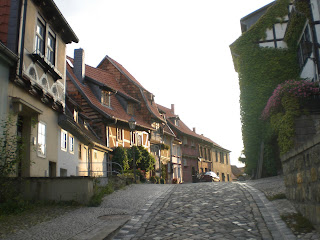Next stop on my tour was to my home town: Leipzig. Last friday, I met a lot of my mates from the Class of '99 for our 10 years' reunion. About half of them were present and it was interesting to see where everybody is, what they do and how many have kids and/ or are married.
Anja lives quite near me, at the Lake of Starnberg so we will see us more often in the future.
Class Picture to come
...
The next days, I spent in Leipzig walking around the city, going to cinema and swimming in the lakes.

Augustusplatz
(city centre with the construction site of the university)
In Markkleeberg, small town next to Leipzig, where I went to school, I visited my aunt and uncle and even though I did not see my cousin in person - his picture was everywhere in as he is a candidate for the upcoming elections for the Landtag (state assembly of Saxony).
 my cousin
my cousin
Yesterday morning, I left for the capital of Saxony: Dresden - it's about 120 km east of Leipzig. There I visited the Zwinger - a complex of baroque buildings surrounding a garden. On a roof top terrace you can nearly walk around the whlole complex having a spectacluar view. Nearby you will find the Semper opera, Taschenbergpalais, the castle and many more landmarks. The Zwinger was commissioned by Augustus the Strong (1670-1733) - elector of Saxony (from 1694) and King of Poland (from 1697) who wanted a palace equal to Versailles.

The Zwinger houses several collections today: Old Masters Picture Gallery, collections of fine art and scientific treasures, Armory, and the collection of Porcelain from China, Japan and Meissen.
Meissen porcelain is the first European hard-paste porcelain that was developed from 1708. The production of porcelain at Meissen, near Dresden, started in 1710 and attracted artists and artisans to establish one of the most famous porcelain manufacturers, still in business today as Staatliche Porzellan-Manufaktur Meissen GmbH. Its signature logo, the crossed swords, was introduced in 1720 to protect its production; the mark of the crossed swords is one of the oldest trademarks in existence. It dominated the style of European porcelain until 1756.

After lunch with Oli from my first executive board in AIESEC Leipzig, I returned to the old city and walked along side the river Elbe and the river bank Terrassenufer. When the rain started, I left in the direction of Berlin.



 Goethe's house
Goethe's house 


 my lunch - typical Thuringian sausage
my lunch - typical Thuringian sausage










 I bought a ticket for the castle at 2 pm but my entry time was more than two hours away, so I started roaming the park of Sans Souci which is filled with trees, flowers and fountains.
I bought a ticket for the castle at 2 pm but my entry time was more than two hours away, so I started roaming the park of Sans Souci which is filled with trees, flowers and fountains.



 my cousin
my cousin






 Julia (my co-trainer) and me
Julia (my co-trainer) and me